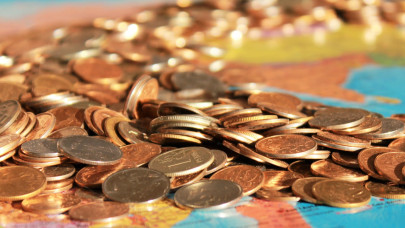The report also sees EUR-RON moving to 5.00-5.10 Ron/€ only in 2025. The governing coalition will run on a common list for the European Parliament elections but not in all local elections, both are scheduled for 9 June.
There is an increasing likelihood of tax increases in 2025 Romanian politicians have agreed to hold elections for local administrations and the European Parliament (EP) on 9 June, in defiance of a 2012 ruling by the Constitutional Court. The ruling Social Democratic Party (PSD) and National Liberal Party (PNL) thus hope that mayors, local and county council members invested in their reelection will also boost their parties' results in the EP election, to offset the protest vote that usually favors fringe parties. Presidential elections will probably be brought forward to September from November. This would allow President Klaus Iohannis to run for an EU position, if his plans to become the next NATO secretary general fail. Finally, parliamentary elections could be held on time, after 6 December.
Despite the busy electoral schedule, the future government is very likely to include the PSD and the PNL, which are currently polling at 28-30% and 15-25%, respectively. Redistribution would give them a simple majority. The two parties will run on a common list in the EP election, but not in all local elections. Negotiations to field a common presidential candidate are ongoing. The Hungarian minority party (UDMR) could join the next government, guaranteeing a majority if the PSD and the PNL underperform. Three more parties could enter parliament, namely the center-right coalition United Right (DU, currently polling at 12-20%) and two nationalist and populist parties that oppose a closer EU: the Alliance for the Union of Romanians (AUR), polling at 10-20%, which aims for a union with Moldova , and the pro-Russian SOS Romania, polling at 4-10% (the threshold is 5%).
The current PSD-PNL government intends to postpone the fiscal adjustment to 2025, until after elections. Finance Minister Marcel Boloș has ruled out any tax increases in 2024, despite the 2M24 cash budget deficit being estimated at around RON 29bn (1.7% of GDP), the highest on record. We expect Romania to run a budget deficit of around 6.3% of GDP this year. We do not believe that tax collection will improve in 2024, while windfall tax revenues and profit transfers from energy companies will fall compared to 2023 as prices declined in Europe. Election-related spending, transfers to local authorities, and wage and pension increases will increase budget expenditure.
Prime Minister Marcel Ciolacu mentioned potential tax increases in 2024 if the budget deficit exceeds 5% of GDP. We see a low probability of this happening because parliamentary elections cannot be held before December. Instead, public investment might be cut, although its propensity to crowd out infrastructure spending has fallen since 2020. That said, we expect the tax environment to change rapidly after parliamentary elections.
Marcel Ciolacu has mentioned three potential tax changes:
1. a unified 16% direct tax rate (on income, profits, dividends, microenterprises and professionals), with potential tax exemptions for reinvested profits;
2. progressive tax rates on personal income (e.g. 10% and 20-25%) and
3. VAT rates increased by 2-3pp. The first and third options would be easier to implement than the second option, which is hindered by the limited technical capabilities of the tax authority (ANAF).
UniCredit experts expect a mix of measures, including higher taxes on income, profit, property, commodities and VAT. A large tax package could push the budget deficit to around 4.7% of GDP in 2025 if it is implemented from January. If the package is postponed to July 2025, then the budget deficit would exceed 5.5% of GDP next year. As always, they expect politicians to opt for higher tax rates, rather than focusing on improving tax collection. The main reasons being expediency and limited institutional capacity.
The forecast for GDP growth is 2.7% this year, with 2.5% seen as boosting reelection chances for incumbents. ”In our view, the main growth drivers will be loose fiscal policy, fast real-income growth, investment in infrastructure and stronger foreign demand in 2H24. The latter factor poses the biggest threat to our forecast,” shows the report.
Private consumption is to remain robust as impeding tax increases almost absent from the media. Construction will benefit from cheaper loans and larger transfers from the EU, while capex might rebound if exports to the eurozone accelerate. In contrast, UniCredit forecast GDP growth at just 1.9% in 2025, as private consumption could grow by just 1.3% due to a raft of tax increases. Depending on the structure of fiscal measures, private construction and services might be affected as well.
Due to fiscal inaction, the structural C/A deficit will stay above 6% of GDP in 2024, with the external shortfall fully covered by FDI, EU transfers and government borrowing from abroad. Thus, FX reserves are expected to rise further from all-time highs. The C/A deficit could narrow next year amid weaker domestic demand.
”We do not forecast inflation to return inside the target range in 2024-25. We expect headline inflation to be around 5.6% at the end of 2024 and at a similar level in 2025, with weaker domestic demand sending core inflation, excluding tax changes, inside the 1.5-3.5% target range by spring 2025. We forecast core inflation to remain stickier than in the rest of the region in 2024,” shows the report.
NBR is expected to start cutting the policy rate in May, bringing it to 6% by the end of 2024. These cuts will lock in the easing achieved through loose liquidity conditions. The effective interbank interest rate was 5.7% in February, equivalent to five rate cuts. Even if the government increases VAT next year, the NBR is expected to cut the policy rate further to 4.5%, focusing on inflation, excluding tax changes. Rate cuts would be warranted by a faster-than-expected narrowing of the output gap, if the fiscal policy tightens. NBR is also expected to pursue similar policies after a new board is elected before the summer, with Governor Mugur Isărescu likely to receive a seventh mandate.
Due to the busy election schedule, the NBR might leave it until 2025 before allowing EUR-RON to move into a 5.00-5.10 range, despite the RON gaining around 15% in real effective-exchange-rate terms since late 2019.











